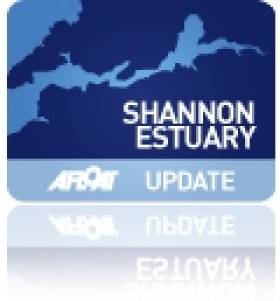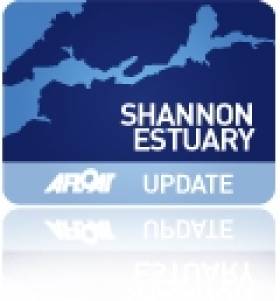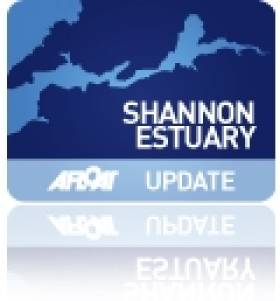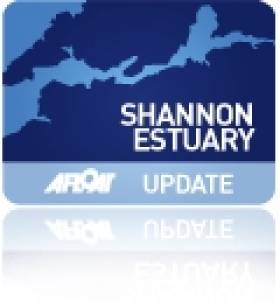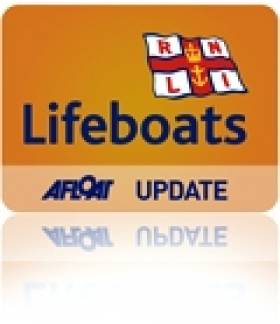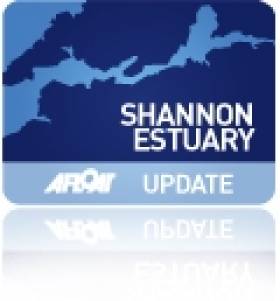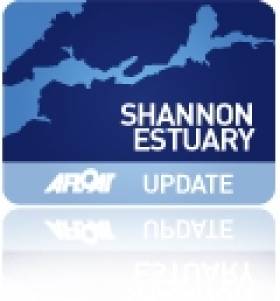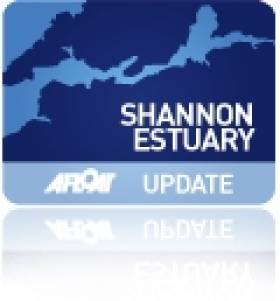Displaying items by tag: Shannon Estuary
EU Funding of €3m to Drive Shannon Foynes Masterplan
#EUPortFund - Funding of €3m from the EU has been secured for Shannon Foynes Port Company, the bulk of which will be spent on building a new East Jetty at the Limerick port, writes The Limerick Leader.
But some €800,000 has also been assigned to examine the feasibility of restoring the rail link to the facility. The East Jetty and the restoration of the rail link are part of the port company's 30-year master plan, Vision 2041. Earlier this year, a seven-year investment plan of €50m got underway and work began on developing the East Jetty which is expected to cost €12.5m.
The €3m funding has come under the Connecting Europe Facility, which has rolled out a record €13.1 billion investment plan for 276 transport projects across Europe. The port company was one of some 700 applicants for the fund and invested considerable time and effort in making the application.
The work on the East Jetty will completed in two phases. The first phase, which has begun, will involve the construction of a retaining wall along berth six, the removal of the existing viaduct and the infilling of 14,500 square metres behind berth six to create substantial new open quay storage.
Preliminary work will also take place on phase two, which involves linking the East and West jetties but construction of phase two is not expected to begin until 2019. The company has repeatedly made clear that it sees the restoration of the rail link as important for the continuing and future development of Foynes and of the estuary generally.
For more on the story click here
#foynesyachtclub – After a late start getting the boats launched, the members of Foynes Yacht Club made the most of the month of May on the water, despite the mixed conditions.
The sailing season kicked off with the annual Cruise to Limerick for the Limerick Riverfest on the May Bank Holiday weekend where 9 cruisers headed off to spend the weekend in the city. The oppie fleet travelled by road to meet them and the young sailors, aged 8 - 14yrs, braved the cold, rain & wind to go for a sail in the city. The cruise in company spent two nights in Limerick docks and had their annual catch up and a few drinks with the Inland Waterways Cruising Club and took in many of the activities going on for the Riverfest.
Commodore's Day was a family affair as Darragh McCormack took 1st place in IRC on his J24 Maximus, while his sister Mary won the dinghy race in the morning and followed that up with a win in the cruiser race in White Sails on their Dufour 35, Alpara. No nepotism involved, honestly! The Competent Crew Course run by Alan McEniff which started with a dry sailing evening in April with 16 participants continued throughout the month during the May Series on Wednesday evenings. Darragh kept the trophy cabinet full by also taking 1st place in IRC for the May Series while Tom Murray, who was relishing the heavy winds, was 1st in White Sails on his Kerry Sloop, Kerry Dream.
The Estuary Rugby Club had their end of year prize giving ceremony in the clubhouse early in the month. The young rugby players also got a taste of sailing as many of the cruiser fleet turned up to take them out in what started out a pleasant enough 15kts westerly before a squall bringing 35kt winds and lashing rain passed through. Luckily enough all the visiting crews were safely ashore by then. After a BBQ (& the rain), the point outside the clubhouse was turned into a rugby pitch for a game of tag rugby. The rugby club extended an invitation to the members for a follow up game at their club.... but I think I'de rather be out in the 35kt winds!!! The local St Senan's Youth Club also concluded their season by bringing about 70 youngsters down to the club for a sail around Foynes Island. For a change the sun peaked its head out & we had a lovely 12-15kts NW, just right for a nice leisurely sail & it was back to the clubhouse after that for another BBQ. Again, many thanks to all the boat owners who made their boats available and gave up their time to take our visitors out. These were two particularly enjoyable evenings in the club and it's great to see so much integration amongst the different clubs in the community.
The dinghy fleet returned to the club after participating in an April Series in Tralee Bay Sailing Club and the TBSC Spring Regatta in early May. FYC held its own Open Dinghy Event on the 3rd weekend in May in 15-18kts WNW breeze with 27 entries. 1st place for Adults in the Open Dinghy Fleet went to Tadgh O'Loinsigh from TBSC while Paddy Cunnane from DSC took 1st in the Junior fleet. 1st in the Oppies went to David McDaid from FYC.
The month concluded with the Munster Mermaid Championships. FYC will host the Mermaid National Championships in August so this was an opportunity for visiting boats to get some practice in local waters before the main event. There were 19 entries with three races scheduled over two days and as anyone who ventured out on the June Bank Holiday weekend knows, conditions were very challenging! Day one brought cold & very blustery 20-25kts winds gusting over 30kts and so the fleet was much depleted by day two which brought saw even stronger winds and even more nasty squalls! 1st place went to Paddy Dillon on Wild Wind (couldn't have been more aptly named!), Darragh McCormack (another trophy!) was 2nd on Innocence and Jim Carthy was 3rd on Vee.
Sailing will continue every Wednesday in June. First gun 1925. Let's hope for better and more consistent weather!
Kilrush RNLI Lifeboat In Multi-Agency Search Operation
#lifeboat – Lifeboat crew launched early this morning to take part in a multi agency search and rescue operation involving Kilrush and Fenit RNLI, Coast Guard rescue teams from Kilkee and Doolin.
At 3.29am Shannon Coast guard tasked Kilrush RNLI volunteer lifeboat crew to investigate a report of four persons in the water in the Poulnasherry Bay area of the Shannon Estuary.
Kilrush lifeboat crew were met by members of the public on the scene who had successfully recovered three persons safely from the water. The casualties were transferred by ambulance to Limerick Regional Hospital. Kilrush RNLI, Kilkee Coast Guard and the Shannon based Coast Guard helicopter undertook a large-scale search of the area to locate a fourth missing person.
The search operation continued through the night with the addition of Fenit RNLI lifeboat, Doolin Coast Guard, Irish Customs Vessel, Ballybunnion Rescue Services, SFPC Pilot Boat as well as an extensive shore search team from all agencies as well as navy diving units.
A person was recovered from the water at 10.42am following an extensive search.
Commenting on the callout, Pauline Dunleavy, Kilrush RNLI Lifeboat Operations Manager said: 'This was one of the largest search and rescue operation in the Shannon Estuary for a number of years. I would like to commend the quick response from all agencies especially the members of the public that assisted. On behalf of everyone at Kilrush RNLI Lifeboat Station, I wish to express our sincere condolences to the family and friends of the man who sadly did not survive.
Foynes Port Redevelopment Continues With Dredging Operations
#EastJettyInfill – Work on a major €50 million investment of Foynes Port that began in February to transform the Shannon Estuary port into one of the biggest bulk harbours in Europe continues with dredging operations, writes Jehan Ashmore.
The restructuring work of Foynes Port sees the redevelopment of the East Jetty which forms phase one of the work costing €12.5m towards the in-filling of 3.45 acres.
When completed this new open quay storage area will cater for 40,000dwt vessels to berth alongside to load and will enable improved bulk cargo discharge times.
According to Shannon Foynes Port Company, the Notice to Mariners No. 2 of 2015 states that the Jenny T, a suction dredger/dump barge is anticipated to carry out dredging and associated dumping works for approximately two weeks, dependent on weather conditions.Operations will be restricted to daylight hours only.
At the neighbouring West Jetty, this forms phase two of the project as this stretch of the Co. Limerick Port will be connected with the East Jetty.
The expansion of the port will add an additional 35,000 square metres of additional bertage and create more open quay storage at the port.
SFPC also plan over time to be able to accommodate 80,000 tonnes capacity vessels, the world's largest cargo vessels to unload at Foynes, making it one of the few ports in Europe capable of handling these massive ships. Currently these vessels transit the Panama Canal.
Union Chandlery Foynes Laser Spring Series Concludes
#shannonestuary – Foynes Yacht Club's dinghy fleet has been undergoing something of a revival in the past 6 months. For the first time in a number of years the club has continued sailing throughout the winter and has just concluded the Laser Spring Series which ran throughout February and March.
20 competitors in total took part over the 9 weeks with an average of 14 boats out each week. Given the mixed weather conditions at this time of year the fleet allowed for some flexibility with regard to racing on Saturdays or Sundays with aim of getting out on the water as many weeks as possible. The organising group made the call each Thursday evening and the result was racing 7 out of the 9 weeks and 16 out of the scheduled 18 races taking place. There were 5 new additions to the laser fleet this spring and they certainly didn't get the easiest introduction to dinghy racing. Huge credit goes to each of them, in particular the juniors as young as 14 years, for coming out every week.
They all agree they've pretty much mastered the skill of capsizing and righting the boat again at this stage!
At the prizegiving presentation Laser Class Captain Cathal McMahon thanked Union Chandlery in Cork, the main sponsors, for their generous prizes. He also thanked the OOD's & rescue crews and Reidy's Centra in Foynes & Clifford's Cash and Carry in Tralee for sponsoring the much appreciated soup and rolls after racing.
The club have been liaising with other clubs along the west coast to promote dinghy sailing and had a number of visiting boats from Tralee Bay Sailing Club for the series. As a follow on 10 boats from FYC have travelled to Tralee as they get their dinghy season up and running with an April Series running over the next four weeks.
FYC will also hold an Open Dinghy Regatta on Saturday May 23rd & Sunday May 24th and hope to see sailors from a few more clubs at what promises to be a 'competitive' but 'fun' event.
Kilrush RNLI Lifeboat on Standby Following Aircraft 'Pan-Pan' Radio Call
#lifeboat – Kilrush RNLI on the Shannon Estuary was put on standby yesterday following a Pan-Pan urgency on board a small aircraft while on approach to Shannon airport.
An alert was received from Valentia Coast Guard yesterday afternoon at 3.06pm (Sunday 1 February) following a report that a small aircraft with six people on board had issued a Pan-Pan radio call as it approached Shannon Airport. It is understood the plane was experiencing fuel difficulties.
The volunteer crew assembled within minutes and prepared their inshore lifeboat for standby.
At 3.46pm, the plane made a safe landing at Shannon Airport. The Coast Guard requested the lifeboat and the crew to stand down.
Commenting on the call out, Pauline Dunleavy, Kilrush RNLI Lifeboat Operations Manager said: 'I would like to commend our crew for their quick response this afternoon in getting to the station and preparing the lifeboat for launch. Thankfully the aircraft was able to make a safe landing today.'
Plane 'Cargo Hold Fire Alert' Leads to Kilrush Lifeboat Call Out
#rnli – An early morning airline alert for Kilrush RNLI lifeboat gave its new Lifeboat Operations Manager her first callout in charge.
Newly appointed Lifeboat Operations Manager (LOM) at Kilrush RNLI, Pauline Dunleavy, had her first callout in charge of the Clare lifeboat station on the Shannon Estuary, when an alert was received early this morning (14 December 2014) and the lifeboat was launched to reports that a plane flying overhead had observed an indication that a fire may have broken out in the cargo hold.
In these circumstances it is standard procedure to launch the lifeboat and it gave Pauline a chance to see how fast the lifeboat can be launched and the response of the volunteers in times of emergency. Pauline was a helm at the lifeboat station before she stood down recently to take up the role of Lifeboat Operations Manager from the outgoing one, John Lambe.
The lifeboat was launched at 9.20am and kept a presence on the river before they learned that the flight, which was en route to France, had landed safely at Shannon airport and they were stood down.
Commenting on the callout Kilrush RNLI Lifeboat Operations Manager Pauline Dunleavy said, 'During my first callout in this new role, it was great to see the lifeboat crew respond to an emergency from the other side. I had the opportunity to see the work the lifeboat crew do and it showed me that with their ongoing training, our volunteers are ready for anything.'
'Thankfully in this instance we were stood down and everyone was safe but it does give us an opportunity to test our responses and to be ready to launch to anything. I know this role is a hugely important one at a lifeboat station and I look forward to working with everyone involved in Kilrush RNLI.'
Foynes Yacht Club Dinghy Fleet Numbers On The Rise
#foynes – Foynes Yacht Club dinghy fleet has exploded this summer and is going from strength to strength writes Elaine O'Mahoney. It started with a conversation in the club bar in the latter part of the summer amongst a small number of members where it was agreed a revival of dinghies in the club was needed and the Laser One was the preferable choice. Club members scoured the country and within a few weeks the fleet went from one laser to ten.
The yacht club has had a excellent season with take up in the both the Adult Learn to Sail Programme run by Alan Mc Eniff on Wednesday nights throughout the season and the Foynes Yacht Club Sailing Academy helping the younger members of the club get to grip with our beautiful sport using the club owned Topaz & Oppie dinghies. For the first time in many years the academy has travelled to open dinghy events in local clubs in Dingle, Tralee and Cullaun Sailing Clubs. The pathway has also been created for the juniors starting in the academy on the Topaz to move onto either purchase their own dinghy, join the Dublin Bay Mermaid fleet or start sailing with the cruiser class.
Saturday mornings were a busy time for the club with supervised dinghy sailing taking place throughout the season which according to Commodore James McCormack has laid the foundations for the renewed interest in dinghy sailing in particular with the junior members. The Saturday morning sailing concluded with a one day regatta at the end of September in which there were 27 boats taking part, of which, five were lasers owned by club members. By the end of the first Laser Series which was run during October there were ten lasers competing for the top spot.
So while the cruisers lifted out at the end of October the introduction of the Laser dinghy fleet meant that the season was extended for some with the Laser November Series, which concluded last weekend after completing a full race card schedule of 10 races. The club are very grateful for the support of Brian O'Sullivan from O'Sullivan's Marine in Tralee who sponsored the October Series and Peter Clifford from Clifford's Cash and Carry in Tralee, sponsor of the November Series.
Racing will take a break for December and January and return on Saturday mornings in February. The club have appointed their first Laser Class Captain, Cathal McMahon, who will have a busy 2015 given the rate at which lasers are appearing at the club. Currently the fleet is up to an astonishing sixteen boats and rumour has it Santa Clause will be bringing another laser or two to Foynes this Christmas!
#shannonestuary – Clare County Council says the zoning of more than 345 hectares of land along the Shannon Estuary will give 'greater investor confidence' for anyone considering large-scale marine related development proposals.
The Council's 28 Elected Members last evening (Monday) unanimously backed the move to incorporate the zoned lands into the Clare County Development Plan 2011-17 along with the Strategic Integrated Framework Plan (SIFP) for the Shannon Estuary, a major strategic plan for the future development and management of marine-related industry and tourism along Ireland's largest estuary.
The newly zoned lands relate to Strategic Development Locations (SDL) at Cahercon and Moneypoint where existing pier facilities and deep estuarial water provide potential for maritime industry investment.
Clare County Council says it would welcome any opportunity to discuss suitable development proposals for the locations.
A new working group has also been established to promote and market the sites and wider Estuary as a key investment location. Led by Clare County Council, the group also comprises the IDA, Shannon Group plc, Shannon Foynes Port Company, Kerry County Council, and Limerick City and County Council.
"The zoning of lands at Cahercon and Moneypoint complements the vision of both the SIFP and the Clare County Development Plan, and will deliver greater investor confidence," stated Tom Coughlan, Chief Executive of Clare County Council and Chairman of the SIFP Steering Group.
He explained: "While the SIFP attributes a very strong weight to the growth of shipping and safeguarding the commercial shipping lanes of the Shannon Estuary, it also contains objectives for marine tourism, leisure and recreation, commercial fishing and aquaculture, aviation, and energy and renewable energy. The Council's decision to zone 345 hectares of land is significant in the context of being able to widely promote these new development opportunities. The IDA's marketing of the estuary's development potential alongside other key development agencies in Clare, Kerry and Limerick is very much welcomed."
"The Council would welcome any opportunity to meet potential investors to discuss suitable development proposals, particularly in relation to marine industry, for the sites in question," added Mr. Coughlan.
Commenting on the background to the zoning of lands along the Shannon Estuary, Clare County Council's Senior Planner Gordon Daly said: "Clare County Council, through the zoning of these lands and the County Development Plan, is seeking to build on the strategic location and natural resources of the Estuary by facilitating and maximising its potential for marine-related industry development while at the same time managing and protecting its environment in conformance with the requirements of the Habitats & Birds Directives."
Moneypoint SDL comprises approximately 280 hectares is located on the Shannon Estuary 5km east of Kilrush. The landbank also includes one of Ireland's largest electricity generation stations.
Mr. Daly commented: "The marine related industry zoning recognises the importance of the existing Moneypoint Power Plant Facility and facilitates its expansion and/or redevelopment. It also includes over 50 hectares of lands to the east of the Power Plant not in the ownership of the ESB that could further harness the deepwater potential in this area which has excellent road access and is close to the town of Kilrush and the Killimer-Tarbert Ferry."
The Innismurry / Cahercon SDL meanwhile, comprises approximately 66 hectares of land
"This area has potential for development of marine related industry due to a well-sheltered location with an existing pier offering direct access to a large pocket of well sheltered deep water and the main navigation channel. It also has a considerable area of hinterland available and is in close proximity to the R473," explained Mr. Daly.
Mr Daly also confirmed that the zoning for Marine Related Industry only allows for the use of land for industry that, by its nature, requires a location adjacent to estuarine/deep water including a dependency on marine transport, transhipment, bulk cargo or where the industrial processes benefit from a location adjacent to the marine area.
The Shannon Estuary features 500km2 of navigable water running from Loop Head and Kerry Head as far as Limerick City, a distance of 100km. The Estuary is Ireland's premier deepwater port, routinely catering for ships up to 200,000 deadweight tonnage, with key ports at Limerick and Foynes. It is home to a number of large industries and employers, including ESB Moneypoint, Aughinish Alumina, Tarbert Power Station, Shannon Airport and NORA Fuel Reserve. Meanwhile, the Estuary supports a variety of economic uses but is also rich in natural resources, wildlife and ecosystems.
Green Light Expected Soon On Foynes Jetty Project
#FoynesJettyProject - The Limerick Leader writes that the name of the successful contractor who will carry out a multi-million upgrade of the east jetty at Foynes will be announced shortly by Shannon Foynes Port Company.
The project, which the SFPC says will cost in excess of €10m, will be the largest single investment at Foynes port since the extension of the west jetty in 1999.
The project is part of the port company's masterplan, Vision 2041, in which it anticipated that the east jetty project would deliver some 150 jobs at the construction stage.
The work on the east jetty is expected to be completed in two phases. To read more about both stage of the project and more click HERE.


























